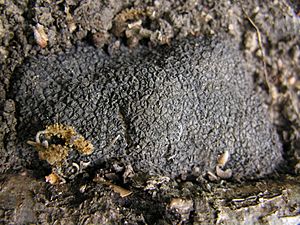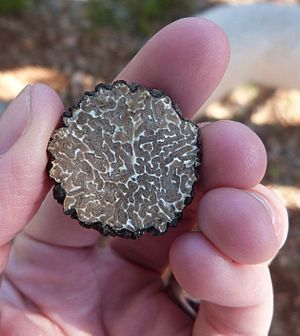Black truffle facts for kids
Quick facts for kids Black truffle |
|
|---|---|
 |
|
| Fruiting body of Tuber melanosporum | |
| Scientific classification | |
| Genus: |
Tuber
|
| Species: |
melanosporum
|
| Tuber melanosporum | |
|---|---|
| Mycological characteristics | |
| glebal hymenium | |
| hymenium attachment is not applicable | |
| lacks a stipe | |
| ecology is mycorrhizal | |
| edibility: choice | |
The Tuber melanosporum, often called the black truffle, Périgord truffle, or French black truffle, is a special type of truffle. It grows naturally in Southern Europe. This truffle is one of the most expensive edible fungi in the world. In 2013, a kilogram of black truffles could cost between 1,000 and 2,000 euros!
Contents
What Does the Black Truffle Look Like?
Black truffles are usually round and dark brown. Their outer skin is black-brown and covered with small, pyramid-shaped bumps. They have a very strong, pleasant smell. Most black truffles grow up to 10 centimetres (4 inches) across. However, some can be much bigger. For example, a black truffle found in 2012 in Dordogne, France, weighed 1.277 kilograms (2.82 pounds)!
When you cut a black truffle, its inside is first white, then it turns dark. It has white lines (veins) running through it, which become brown as the truffle gets older. The tiny spores (like seeds) are oval-shaped and dark brown, covered with small spikes.
In the Northern Hemisphere, black truffles grow from April to June. They are usually ready to be found and harvested from November to March.
Scientists used to think that all truffles could reproduce by themselves. But research in 2010 showed that black truffles need two different types of their "roots" (called mycelia) to meet to create new truffles.
Black Truffle's Amazing Smell and Taste
The black truffle has a unique smell. Some people say it smells like damp forest ground, strawberries, wet earth, or dried fruit with a hint of cocoa. Its taste is slightly peppery and a bit bitter. The full flavor of the truffle really comes out when it is heated.
If you leave truffles at room temperature, their amazing smell fades away. But if you store them in a very cold place, close to freezing (0°C), they actually make more of their special smell.
The strong smell comes from tiny chemicals called volatile compounds. One of these, called dimethyl sulfide, is what helps truffle dogs, truffle hogs, and truffle flies find the hidden truffles underground.
The Science Inside Black Truffles
Scientists have studied the genetic code (the genome) of the black truffle. They found it has 125 million base pairs. About 58% of its genome is made of special moving DNA pieces. It also has about 7,500 genes that make proteins.
Black truffles also contain a chemical called anandamide. This chemical is similar to ones found in our own bodies. It might be an ancient way for truffles to attract animals that eat them, helping to spread their spores.
Truffles That Look Similar
The black truffle looks a lot like the Chinese truffle (Tuber indicum). The Chinese truffle is not as valuable. To make sure people don't get confused or cheated, scientists have developed a special genetic test to tell them apart. You can also tell them apart by their skin: the Chinese truffle's skin is smoother and dark red or dark brown.
Two other truffles that look a bit like the black truffle are the summer truffle (Tuber aestivum) and the winter truffle (Tuber brumale). Their insides are much lighter in color.
Who Named the Black Truffle?
The Italian scientist Carlo Vittadini was the first to officially describe the black truffle in 1831.
Where Do Black Truffles Grow?
Black truffles grow underground, usually about 5 cm (2 in) to 50 cm (20 in) deep. They prefer loose, chalky soil. They grow very close to the roots of certain trees, forming a special partnership called an ectomycorrhiza. These trees include holm oaks, French oaks, hazel trees, cherry trees, and other deciduous trees (trees that lose their leaves in autumn). This partnership actually helps the trees grow better and take in more sunlight.
You might notice that black truffles make the area around their partner tree look like a "burnt" spot (called a brûlé). This happens because the truffles affect the roots of other nearby plants, which can cause those plants to die. Also, some of the smell from the truffles might stop other plants from growing too well.
How Black Truffles Reproduce and Spread
Wild Boars and the tiny larvae of a truffle fly (Suillia tuberiperda) love to eat black truffles. When they eat the truffles, they help spread the indigestible spores (seeds) through their droppings. These droppings might even help the spores grow! Sometimes, black truffles are found growing near winter truffles, which can help black truffles grow better in wet soil.
Where Are Black Truffles Found?
Black truffles naturally grow in different parts of Spain, France, Italy, and Croatia. These are likely the places where their host plants survived the last Ice Age. In these areas, finding and growing black truffles has been a tradition for over 200 years. People still collect truffles by hand in many natural forests. For example, in the Alto Maestrazgo region of Spain, the ground is perfect for growing truffles. Many villages there, like Albocàsser and Morella, are known for finding lots of black truffles.
However, climate change has started to affect how many truffles grow naturally. Since 2010, there has been a big drop in the number of truffles found in natural forests.
Growing Black Truffles on Farms
To grow more truffles, farmers need to make sure that the trees they plant have the right types of truffle mycelia (the truffle's "roots") around them. They can do this by adding the right mycelia to young trees before planting.
More and more areas are now used for growing truffles. In central Spain, thousands of hectares (large areas of land) are dedicated to truffle farming. Sarrión, in the Teruel province, is a very important place for black truffle farming.
Black truffles are now also grown in other countries like Australia, New Zealand, Chile, North America, Argentina, South Africa, and Wales. To grow them, farmers plant trees like hazel trees, whose roots have been treated with truffle mycelium. The first truffles can usually be harvested about 4 to 10 years after the trees are planted.
France produces about 45% of the world's black truffles, Spain 35%, and Italy 20%. Smaller amounts come from the United States, South Africa, Slovenia, Croatia, and parts of Australia. In 2005, black truffles were even found in Serbia.
Most of France's truffle production (about 80%) comes from the southeast. The biggest truffle market in France (and probably the world) is in Richerenches. Another big market in southwest France is in Lalbenque. These markets are busiest in January, when black truffles smell their best.
The total amount of black truffles produced has gone down a lot in the 21st century. It's now around 20 metric tonnes per year, with about 46 tonnes in the best years. This is much less than in 1937, when France alone produced about 1,000 metric tonnes!
The table below shows how much T. melanosporum was produced in Spain, France, and Italy. The numbers are in metric tonnes.
| Years | Spain | France | Italy | EU Total | % of average year | Spain vs EU | France vs EU | Italy vs EU |
|---|---|---|---|---|---|---|---|---|
| 1990/1991 | 30 | 17 | 5 | 52 | 83 | 58 | 33 | 10 |
| 1991/1992 | 10 | 20 | 5 | 35 | 56 | 29 | 57 | 14 |
| 1992/1993 | 23 | 31 | 3 | 57 | 90 | 40 | 54 | 5 |
| 1993/1994 | 9 | 22 | 2 | 33 | 52 | 27 | 67 | 6 |
| 1994/1995 | 4 | 12 | 30 | 46 | 73 | 9 | 26 | 65 |
| 1995/1996 | 20 | 19 | 25 | 64 | 102 | 31 | 30 | 39 |
| 1996/1997 | 25 | 50 | 20 | 95 | 151 | 26 | 53 | 21 |
| 1997/1998 | 80 | 30 | 24 | 134 | 213 | 60 | 22 | 18 |
| 1998/1999 | 7 | 14 | 4 | 25 | 40 | 28 | 56 | 16 |
| 1999/2000 | 35 | 40 | 10 | 85 | 135 | 41 | 47 | 12 |
| 2000/2001 | 6 | 35 | 4 | 45 | 71 | 13 | 78 | 9 |
| 2001/2002 | 20 | 15 | 5 | 40 | 63 | 50 | 38 | 13 |
| 2002/2003 | 40 | 35 | 20 | 95 | 151 | 42 | 37 | 21 |
| 2003/2004 | 7 | 9 | 6 | 22 | 35 | 32 | 41 | 27 |
| 2004/2005 | 22 | 27 | 10 | 59 | 94 | 37 | 46 | 17 |
| 2005/2006 | 14 | 15 | 8 | 37 | 59 | 38 | 41 | 22 |
| 2006/2007 | 20 | 28 | 10 | 58 | 92 | 34 | 48 | 17 |
| 2007/2008 | 25 | 26 | 8 | 59 | 94 | 42 | 44 | 14 |
| 2008/2009 | 14 | 58 | 20 | 92 | 146 | 15 | 63 | 22 |
| 2009/2010 | 9 | 32 | 8 | 49 | 78 | 18 | 65 | 16 |
| 2010/2011 | 18 | 37,2 | 12 | 67,2 | 107 | 27 | 55 | 18 |
| 2011/2012 | 14,5 | 42,3 | 8 | 64,8 | 103 | 22 | 65 | 12 |
| 2012/2013 | 15 | 38,2 | 20 | 73,2 | 116 | 20 | 52 | 27 |
| 2013/2014 | 45 | 50 | 30 | 125 | 198 | 36 | 40 | 24 |
The table shows that France has been the top producer of black truffles recently. But Spain is quickly catching up! In Spain, especially in the Teruel province, growing black truffles has become the most important economic activity. This is partly because of special programs that help pay for truffle farms.
How Are Black Truffles Used?
Black truffles are the second most expensive truffles, after white truffles. They are one of the most desired edible mushrooms in the world.
In cooking, black truffles are used to make many dishes taste even better. They are added to meat, fish, soups, cheeses, and risotto. Unlike white truffles, the smell and flavor of black truffles get stronger when they are heated. They are often shaved thinly over a dish or mixed into high-quality olive oil or butter.
Images for kids
See also
 In Spanish: Trufa negra para niños
In Spanish: Trufa negra para niños



